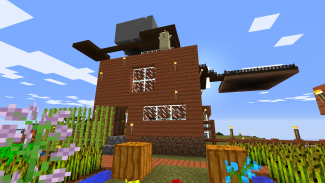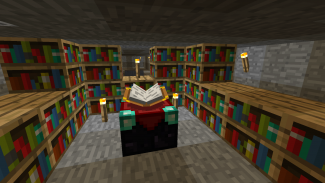
Johns Hopkins UniversityEst. 1876
America’s First Research University
Minecraft and Robinson Crusoe

In the Fall 2016 issue of the journal Configurations, Josef Nguyen took a look at similarities between the computer world-building game Minecraft and pieces of fiction like Robinson Crusoe, which rely heavily on the creation of a new world. An assistant professor of game studies at the University of Texas at Dallas, Nguyen engages science and technology studies and media studies in his research, focusing on the politics of play, toys, and games. He joined us for a Q&A to talk about his essay.
How did you come to link Minecraft with Robinson Crusoe?
When I first heard about Mojang’s Minecraft (2009/2011), I heard it described as a survival game where players must gather resources and build to survive. As a result of my literary studies, I immediately draw comparisons of cultural texts premised on being stranded and needing to survive to Daniel Defoe’s novel Robinson Crusoe (1719)—especially with the historic and enduring popularity of robinsonade narratives. Johann David Wyss’ novel The Swiss Family Robinson (1812), R. M. Ballantyne’s young adult adventure The Coral Island (1858), and Robert Zemeckis’ film Cast Away (2000) are some of the many examples of popular cultural narratives that have been influenced by the character of Robinson Crusoe, his island, and his inventive solutions. Several journalists, game critics, and webcomic artists have also made the comparison, either explicitly by name or with descriptions similar to Robinson Crusoe’s ordeal on his remote island. Something I found particularly interesting about this link is that, in rereading Robinson Crusoe after having played Minecraft myself, the book can be read like a player’s personal account of their gameplay experiences in Minecraft: cataloguing various activities, experiments, errors, and discoveries in their pursuit of survival.
How can stories like Robinson Crusoe help people who do not play Minecraft better understand the game?

What does Minecraft's widespread popularity with both children and adults suggest about current attitudes toward digital games?
Consider Minecraft’s popularity given the persistent media panic about digital games ruining the youth. People worry about digital games leading to idleness, antisocial behavior, and violence, and those concerns have lurked for several decades, Minecraft is treated as an exception, particularly as it is increasingly framed as an educational game or a platform for educational play at home and in schools. This characterization represents a large cultural shift that acknowledges digital games as good for or even vital to children and their development. That said, I think expressly educational games are seen as generally unsuccessful the majority of the time, with a few notable wildly successful titles, like MECC’s The Oregon Trail (1974) and Brøderbund’s Where in the World Is Carmen San Diego? (1985). Educational games are often treated with skepticism as they must be both fun and instructional without one interfering or eclipsing the other—a challenge that has proven to be extremely tricky as fun and educational have largely been conceived of as opposing goals. Moreover, the majority of educational games are designed for specific content, but Minecraft, as its championed as an educational game, has been used as an adaptive interactive platform for instruction in a range of topics, such as circuit design, statistics, and world language instruction. Yet Minecraft itself was not designed to be an educational game. Because its flexible design is predicated on construction, however, it can be used as a tool for instructors to develop their own educational scenarios, lessons, and games. Therefore, even as Minecraft is lauded for its educational potential, it always requires special modding (modification), configuring, or directed lesson plans to serve educational purposes. It does not seem to be used much as a stand-alone educational tool out of the box.
What do you think is the relationship between creative practices in Minecraft and creative practices outside of the game?

What made Configurations the right journal for this article?
Because of the sprawling topical threads I trace in the article in cultural and technoscientific domains—including literary history, the history of toys, the history of psychology, science education, and software literacy—Configurations and its interdisciplinary scope was a compelling option for me. Moreover, I first presented a very early version of the article’s discussion of island narratives and creative subjects at an annual meeting for the Society for Literature, Science, and the Arts, which is the organization for which Configurations is the official journal publication. The positive reception at the conference of the work presented as well as the incredibly helpful feedback signaled to me a strong fit in audience.


